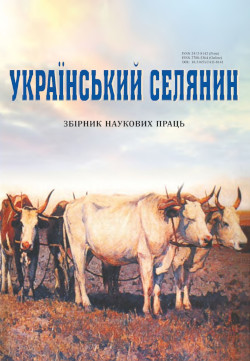From peasants to «protestants» and «psychopaths»: semiotic transformations of peasant religious movements in the orthodox discourse of the late 19th-early 20th century
Main Article Content
Abstract
Abstract. The purpose of this study is to examine the semiotic transformations of peasant religious movements in the
southern Russian Empire during the late 19th and early 20th centuries within the official Orthodox discourse, where these
movements were categorized as manifestations of «Protestantism» or «psychopathology.» The research focuses on the discursive
mechanisms through which the Synodal Church adapted non-systemic religious practices to the conditions of modernization,
influenced by scientistic trends and institutional shifts. It explores how Orthodox theologians, missionaries, and sectarian
scholars constructed the image of peasant sectarians by drawing on Western intellectual constructs, such as Protestantism, and
by pathologizing ecstatic religious practices through a medical lens.
The scientific novelty lies in a systematic analysis of Orthodox discursive practices, with an emphasis on the semiotic
dimensions of categorizing local religious movements, including shtundism, malyovantstvo, and pashkovism. The study establishes
a connection between the academic formation of sectarian studies and the construction of Protestantism as a generalized
model of sectarianism, alongside a correlation between the positivist ideals of the era and the tendency to interpret religious
ecstasy as psychopathology, reinforced by collaboration between the Church and psychiatric institutions.
The findings demonstrate that interpreting peasant religious movements as Protestant or pathological was part of a
broader strategy by the Synodal Church to unify the diversity of religious beliefs within the imperial society. These interpretative
models not only simplified the complex landscape of peasant faith but also provided a theoretical foundation for missionary
activities, reflecting the broader modernization processes that encompassed the social, intellectual, and religious spheres of
the time.
Article Details
References
Aivazov, I. (1909). K dissertatsii D. G. Konovalova «Religioznyi ekstaz v russkom misticheskom
sektantstve» [To the dissertation of D. G. Konovalov: «Religious Ecstasy in Russian Mystical Sectarianism»].
Moskva [in Russian].
Aleksiy (Dorodnitsyn), arkhiep. (1903). Yuzhno-russkiy neobaptizm [South Russian neo-Baptism].
Stavropol. [in Russian].
Bekhterev, V. (1991). Obyektivnaya psikhologiya [Objective psychology]. Moskva. [in Russian].
Bibliograficheskaya zametka (1883). Ekaterinoslavskie eparkhialnye vedomosti (EEV), (19), 369–
[in Russian].
Butkevich, T., prot. (1910). Obzor russkikh sekt [Review of Russian sects]. Kharkov. [in Russian].
Danilov, F. (1906). Slovar politicheskikh, sotsialno-ekonomicheskikh i nekotorykh drugikh slov [Dictionary
of political, socio-economic, and other terms]. Moskva. [in Russian].
Dorodnitsyn, A. (1898). Adventizm i malenvanshchina [Adventism and Malenovanshchina]. Dyaniya
-go Vserossiyskogo Missionerskogo s”ezda v Kazani (2nd ed., pp. 152–154). Kazan. [in Russian].
Enciklopedicheskiy slovar F. Pavlenkova [Encyclopedic dictionary of F. Pavlenkov]. (1910). Sankt-Peterburg.
[in Russian].
Epifanovich, L. (1888). Zapiski po oblichitelnomu bogosloviyu [Notes on polemical theology]. Novocherkassk.
[in Russian].
Kalnev, M. (1897). Nemtsy i shtundobaptizm [Germans and Stundobaptism]. Moskva. [in Russian].
Kniga chinov prisoedineniya k pravoslaviyu. Ch. 2 [Book of rites for joining Orthodoxy. Part 2]. (1915).
Petrograd. [in Russian].
Konovalov, D. (1908) Religioznyi ekstaz v russkom misticheskom sektantstve Chast 1, Vyp. 1. Fizicheskie
iavleniia v kartine sektantskogo ekstaza [Religious Ecstasy in Russian Mystical Sectarianism. Part 1. Vol. 1. Physical
Phenomena in the Picture of Sectarian Ecstasy]. Sergiev Posad [in Russian].
Melgunov, S. (1907). Tserkov i gosudarstvo [Church and state]. [in Russian].
Mitrofan (Abramov), ierom. (1909). Pravoslavnyy protivosektantskiy katekhizis [Orthodox anti-sectarian
catechism]. Zhitomir. [in Russian].
Nahornyi, V. (2013). Konfesiina polityka Rosiiskoi imperii shchodo pravoslavnykh sektantiv ukrainskykh
hubernii v ХIХ stolitti [Confessional policy of the Russian Empire towards Orthodox sectarians of Ukrainian
provinces in the nineteenth century]. Canidat’s thesis. Poltava. [in Ukrainian].
shtundistakh v sele Volosskom Ekaterinoslavskogo uezda [On Stundists in the village of Volosskoye,
Ekaterinoslav district]. (1886). EEV, 8, 193–204. [in Russian].
Pisma preosvyashchennogo Mikhaila, episkopa Tavricheskogo [Letters of His Grace Michael, the late
Bishop of Taurida]. (1910). Simferopol. [in Russian].
Po povodu blagochinnicheskikh otchetov o sostoyanii pastvy Ekaterinoslavskoy eparkhii za 1885 g.
[Regarding the deanery reports on the state of the flock of the Ekaterinoslav diocese for 1885]. (1886). EEV, 4,
–102. [in Russian].
Protasov, D. (1890). Razbor veroucheniya russkikh shtundistov [Analysis of the doctrine of Russian
Stundists]. Tula. [in Russian].
Protokol Komissarovskogo Missionerskogo Komiteta [Protocol of the Komissarovsky Missionary Committee].
(1886). EEV, 11, 173–175. [in Russian].
Protokol Komissarovskogo Missionerskogo Komiteta [Protocols of the Komissarovsky Missionary Committee].
(1886). EEV, 20, 382–384. [in Russian].
Raznogorskiy, M. (1888). Prestupnost i otvetstvennost otstupayushchikh ot pravoslavnoy very i osobenno
ikh lzheuchiteley [Criminality and responsibility of those who deviate from the Orthodox faith, especially their
false teachers]. EEV, 4, 98–116. [in Russian].
Shtunda v Volynskoy gubernii [Stunda in Volyn province]. (1903). Kievskaya starina [Kievskaya Starina],
(6), 149–154. [in Russian].
Tsentralnyi derzhavnyi istorychnyi arkhiv Ukrainy v Kyievi [Central State Historical Archive of
Ukraine in Kyiv].
Turner, V. (1983). Simvol i ritual [Symbol and ritual]. [in Russian].
Uspenskiy, E. (1895). Oblichitelnoe bogoslovie [Polemical theology]. Sankt-Peterburg. [in Russian].
Ushynskyi, A. (1883). Verouchenye malorusskykh shtundystov [Refutation of the Little Russian Stundists].
Kyev. [in Russian].
Yakovenko, I. (1912). Chto zhe delat dalshe? [What to do next?]. EEV, 8, 344–349. [in Russian].

